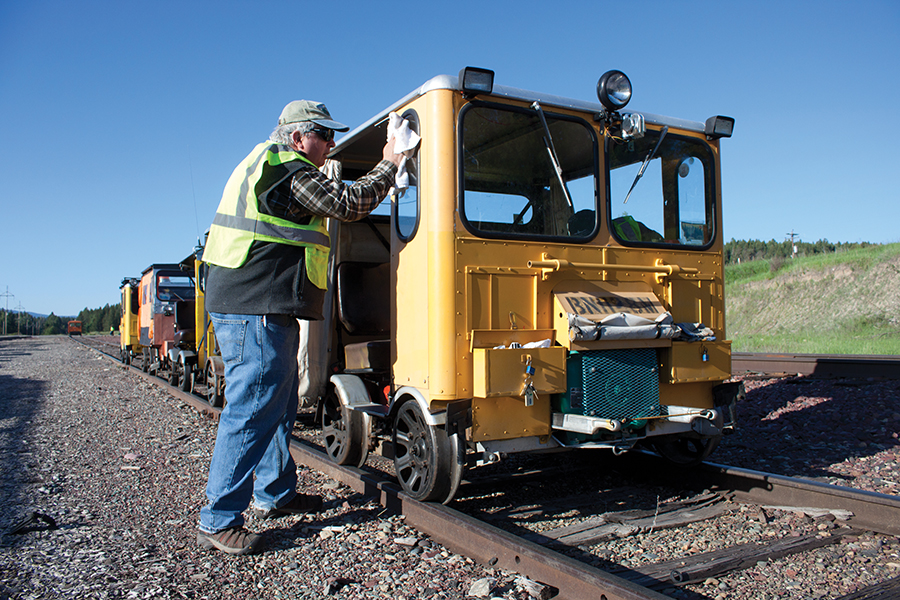FORTINE – Decades ago, John Chase spent his childhood summers in East Glacier Park. While most kids were itching to head for the hills of the national park, one of Chase’s favorite activities during those months away from home was watching passing trains at the Great Northern Railway depot.
Chase can remember the names of the trains that once called on East Glacier Park, like the Empire Builder, the Mail Express and the Oriental Limited, and how he longed to climb aboard and ride the rails.
Today, thanks to a niche hobby with only a thousand or so devotees nationwide, Chase is able to fulfill his long-held dream, albeit in a less luxurious mode of transportation than the express passenger trains of yesteryear. Chase has restored a Great Northern rail motorcar built in 1969 and was one of more than 30 people who took the rails of the Mission Mountain Railroad on June 8 as part of a statewide rail tour starting in Fortine.
A motorcar, also known as a speeder, is a small, motorized rail vehicle that maintenance workers once used to go to and from work sites along the tracks. Today, most modern railroads use regular pick-up trucks outfitted with railroad wheels, but many motorcars still exist in museums across the country. Other motorcars are owned by private individuals who jump at the chance to put their speeders on real rails to tour the countryside and take in the scenery. Many are part of a group called the North American Railcar Operators Association, a nonprofit group with more than 1,800 members. The association, and its affiliate group Pacific Railcar Operators, organizes dozens of motorcar trips annually on rail lines across the continent. Chase has taken his vintage motorcar on trips all across the Pacific Northwest.
“You get an opportunity to see the country from a different perspective and you meet some great people too,” he said, as he polished his motorcar before the run from Fortine. “It’s also my chance to be the engineer.”
The June 8 trip on the Mission Mountain began in Fortine and headed south to Stryker before turning around and heading for Eureka. During the following week, the group of 31 motorcars from 11 different states road rail lines near Missoula, Whitehall and Anaconda.
Pacific Railcar Operators worked with the Mission Mountain and other short line railroads across the state to let its members run their motorcars on the privately owned tracks. The group pays a fee for each motorcar on the tracks.
Doug Stivers is president of Pacific Railcar Operators and hails from San Jose, Calif. He was attracted to the hobby in the early 1990s when his brother first purchased an old motorcar. Stivers tries to make five or six trips a year with his 1948 Fairmont two-cycle engine motorcar that was built for the Western Pacific Railroad and has traveled from Arizona to British Columbia. While the rides on the Montana tour were usually 40 to 70 miles, Stivers once took a trip in northern British Columbia that was more than 1,000 miles.
“The best part of this hobby is that you get to see everything from track level and you can fantasize that you’re actually running a locomotive,” he said.
Unlike a locomotive though, the motorcars are much more moveable. Enthusiasts often haul their speeders on trailers behind their cars or RVs. To turn the motorcar when it’s on the tracks, they can either physically lift it and spin it around on a road crossing or have a mechanical turntable lift the car from the bottom so that they can spin it, like an industrial strength Lazy Susan.
Al McCracken has been a motorcar owner for nearly 20 years and has put more than 20,000 miles on his speeder in the United States, Canada and Mexico. McCracken said his motorcar can move about 20 to 30 miles per hour, but it feels a lot faster because you’re so close to the ground.
“When you’re on one you think you’re going really fast because the rails and the ground is just whizzing by,” he said. “It’s my own version of an off-road vehicle, I just don’t have to steer.”
